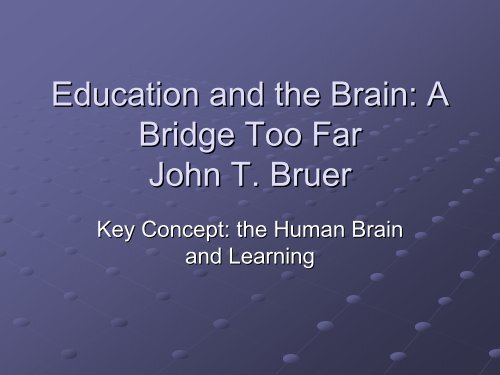Education and the Brain: A Bridge Too Far John T. Bruer - Fordham ...
Education and the Brain: A Bridge Too Far John T. Bruer - Fordham ...
Education and the Brain: A Bridge Too Far John T. Bruer - Fordham ...
You also want an ePaper? Increase the reach of your titles
YUMPU automatically turns print PDFs into web optimized ePapers that Google loves.
He reviewed:• Literature on whatis known about <strong>the</strong>human braindevelopmentthrough researchdone onneurologicaldevelopment of <strong>the</strong>brain from infancy-adulthood.
Fascination with brain science:• Unfortunately, neuroscience has little tooffer teachers in terms of informingclassroom practices• However, science of <strong>the</strong> mind, cognitivescience, serves as a basis for <strong>the</strong>development towards applied science oflearning <strong>and</strong> instruction.• Over <strong>the</strong> past year, numerous books,journal articles, studies, <strong>and</strong> stories havebrought light to our underst<strong>and</strong>ing ofbrain development <strong>and</strong> neural functionwhich could revolutionize educationalpractices.
About this article:• Examines <strong>the</strong> results, interpretations, <strong>and</strong>conclusions: neuroscience vs. educationargument- failed.• Two shorter bridges that indirectly linkbrain function with educational practices:between education & cognitive psychology<strong>and</strong> between cognitive psychology <strong>and</strong>neuroscience.• Newer bridge: seeing how mentalfunctions map onto brain structures.• Cognitive psychology provides <strong>the</strong> onlyfirm ground to anchor <strong>the</strong>se bridges!
In depth Neuroscience <strong>and</strong><strong>Education</strong>al argument:• First- infancy continuing into childhood:dramatic increase in <strong>the</strong> # of synapsesthat connect neurons in <strong>the</strong> brain.• This proliferation(synaptogenesis) isfollowed by synaptic elimination• Second- experience-dependent criticalperiods in <strong>the</strong> development of sensory <strong>and</strong>motor systems.• Third- environments cause new synapsesto form.(tested in rats)
Argument is as follows….• Up to age 10, a child's brain containsmore synapses than at any o<strong>the</strong>r time in<strong>the</strong>ir lives!• Childhood experiences reinforce <strong>and</strong>maintain used synapses while unusedones are snipped away.• Therefore, this period is critical in a child’scognitive development.• “With <strong>the</strong> right input at <strong>the</strong> right timealmost anything is possible!”
“Is <strong>the</strong> earlier really <strong>the</strong> better?”• The claim that children are capable oflearning more at a very early age, when<strong>the</strong>y have excess synapses <strong>and</strong> peak brainactivity• O<strong>the</strong>r articles state that children begin <strong>the</strong>study of language, music, logic <strong>and</strong>advanced ma<strong>the</strong>matics as early aspossible.(3-4)• “Golden opportunity to mold a child’sbrain”- when brain activity is high,excellent time to foster a love of learning
Head start programs <strong>and</strong> CarnegieTask Force evidence:• Head Start programs fail to improvechildren’s s IQ because <strong>the</strong>y begin too latein <strong>the</strong>ir critical learning period.• The Carnegie Task Force report, Years ofPromise, identified <strong>the</strong> years 3-103as acritical period in child development…notnotmany references for <strong>the</strong> hundreds ofcitations…• Results: We cannot look to neuroscienceas a guide to improved educationalpractice <strong>and</strong> policy.
Synaptogenesis• The process of synaptic proliferation• Neonates (infant) brains begin to formsynapses far in excess to adult levels.• The mature nervous system has fewersynaptic connections than were presentduring <strong>the</strong> developmental peak.• Most of what we know of synaptogenesis<strong>and</strong> synaptic pruning comes from animalresearch.
Unlike in animals….• Changes in <strong>the</strong> number of synapses per neuronor changes in synaptic density in our speciesoccurs in various areas of <strong>the</strong> brain.• Occurs very early in human visual cortex• In frontal cortex, synaptic densities do notstabilize until mid-to late adolescence. <strong>Brain</strong> arearesponsible for planning, integrating info, <strong>and</strong>maintaining executive control of cognitivefunctions.• Therefore, what neuroscientist know aboutsynaptogenesis does not support a claim that 0-30is a critical period for humans.
Developmental Milestones ofSynaptogenesis:• 2 months- human infants start to lose<strong>the</strong>ir innate, infantile reflexes• 3 months- infants can reach for an objectwhile visually fixating on it (visual cortex)• 4-55 months- visual capacities increase• 8 months- perform working memory tasks• 18-24 months- synaptogenesis haspeaked in <strong>the</strong> visual cortex, children startuse symbols, speak in sentences, <strong>and</strong>show spurts in acquiring vocab.
Educators should know…• Increases in synaptic density are correlated with<strong>the</strong> initial emergence of skills <strong>and</strong> capacities• Some o<strong>the</strong>r form of brain maturation or changemust contribute to this ongoing development• The development of <strong>the</strong>se capacities supportfuture learning yet give little support about whatkinds of early childhood, preschool, or learningexperiences might enhance children’s s cognitivecapabilities or educational outcomes.• “We simply do not know enough about how <strong>the</strong>brain works to draw educational implications fromchanges in synaptic morphology”~ <strong>Bruer</strong>
How brain structure supportscognitive function:• 1:Connection of educational practicewith cognitive psychology 2:cognitivepsychology with brain science.• Cognitive psychology- study of mind<strong>and</strong> mental function that underlieobserved behavior; <strong>the</strong> basic scienceof learning <strong>and</strong> teaching.• Examples: word recognition &grammatical processing
<strong>Brain</strong> imaging technologies:• Positron Emission Tomography(PET)- measureschanges in cerebral blood flow, oxygenutilization, <strong>and</strong> glucose utilization linked to neuralactivity.• Functional Magnetic Resonance Imaging (fMRI(fMRI)-measures changes in <strong>the</strong> ratio of oxygenated <strong>and</strong>deoxygenated hemoglobin• These methods allow us to see cognitive taskchange brain activity• Therefore, help us localize areas of brain activitythat underlie <strong>the</strong> various cognitive components
2 examples on how cognitive psychology linkeducational questions with cognitive neuroscience:• <strong>Education</strong>al problem: learning elementary schoolarithmetic- ability to do numerical comparisons isan acquired skill• Field of cognitive neuroscience: conducted aseries of brain-recording recording experiments to traceneural circuitry involved in making suchcomparisons• These examples show: <strong>the</strong>re is no way we couldunderst<strong>and</strong> how <strong>the</strong> brain processes numbers bylooking at children’s s classroom or math curricula<strong>and</strong> be able to design a math curricula based on<strong>the</strong> results.
What it does show:• Possibilities of being able to see howlearning <strong>and</strong> instruction alter brainactivity, <strong>and</strong> compare <strong>the</strong>se learningrelated changes in normal versusspecial learning populations.• Also, help us to develop betterinstructional interventions to addressspecific learning problems
In conclusion…..• Though neuroscience has discovereda great deal of info. about neurons<strong>and</strong> synapses, it is still not enough toguide educational practices.• Cognitive psychology is a better betin regards to basic science help toguide educational practice & policy.
















